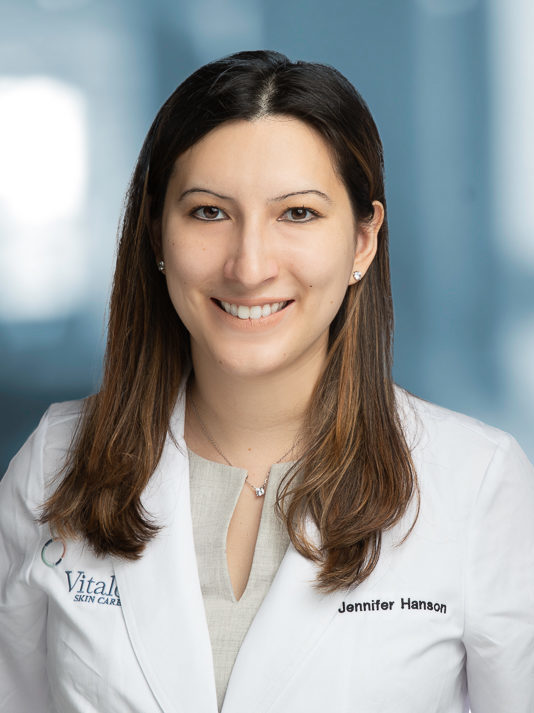Dr. Jennifer Hanson answers questions about skin cancer, Mohs surgery, tanning beds and more.
Sponsored content by Vitalogy Skincare, Featured photo by Arturo Rivera on Unsplash

According to the American Cancer Society, skin cancer is the most common cancer in the United States, with women age 49 and under more likely to develop melanoma than any other cancer except breast and thyroid cancers. Dr. Jennifer Hanson, a board-certified dermatologist and fellowship-trained Mohs surgeon, sits down to chat with us about skin cancer, Mohs micrographic skin surgery, indoor tanning and her favorite ways to help prevent skin cancer, including her favorite sunscreens.
I grew up in New Jersey, just outside of Manhattan. After graduating from Columbia University, I completed my medical training, dermatology residency and a fellowship in Mohs micrographic surgery and dermatologic oncology at the Mayo Clinic in Rochester, Minnesota. After so many years living in colder climates, I am delighted to be part of our Austin community. I’m passionate about practicing medicine, traveling, trying new food, exercising and interior design. Family time with my young daughter, husband and two little dogs revitalizes me.
Austin loves its outdoor activities. What are your top three tips to help lower our risk for skin cancer?
First, practice sun safety with a combination of sunscreen application and photoprotective clothing, including a wide-brimmed hat. Don’t forget your eyes; wear sunglasses with UV protection. Second, avoid outdoor activity or seek shade when UV rays are the strongest between 10 a.m. and 4 p.m. Third, use a broad-spectrum sunscreen, meaning one that protects against both UVA and UVB rays and has a minimum SPF of 30, and reapply at least every two hours and after swimming and perspiring. A common mistake is not applying a generous coat of sunscreen. According to the Skin Cancer Foundation, this means two tablespoons, or a shot glass, of sunscreen to exposed areas of the face and body, a nickel-sized application to your face alone. I am generous with my application and reapplication.
What skin cancer tips do you share most often?
If something does not seem right—a new growth, changing lesion, bleeding or otherwise symptomatic lesion—please see a dermatologist immediately. If you have a history of skin cancer, you are more likely to develop skin cancer again. So be diligent about self-skin exams and annual skin exams with your dermatologist. The most common areas to see skin cancers are on the scalp, face, nose, lips, ears, neck, chest, arms and hands. It can also affect areas protected from the sun, such as between your toes or genital area. Melanoma most often appears on the face or the trunk of men and lower legs of women.
Know that skin cancer affects all skin tones. When melanoma occurs in people with darker skin tones, it’s more likely to be found on the nails, palms and soles. Exposure to ultraviolet light—sunlight and tanning beds—is the main risk factor for skin cancer. Finally, just one blistering sunburn as a child or adolescent can double a person’s chances of developing melanoma later in life. So follow these tips diligently with your family.
Talk to us about tanning beds.
According to a study published in JAMA: The Journal of the American Medical Association, women who have ever tanned indoors are six times more likely to be diagnosed with melanoma in their 20s than those who have never tanned indoors. Most tanning beds expose you to ultraviolet A (UVA) radiation, which reaches deep into the skin to cause damage. This also exposes the myth of base tans. Any tanning damages the skin and does not protect against sunburns or skin cancer. I recommend sunless tanning lotions to get that summer glow. And I remind everyone that tanning causes aging—think wrinkles, age spots and loss of skin firmness.
Tell us about your favorite sunscreens.
I prefer non-spray-on sunscreens to avoid breathing in the particles. The best sunscreen is the sunscreen you use. For me, that includes EltaMD, Revisions and skinbetter science, whose sunscreens apply well and come in chemical and physical forms.
Mohs micrographic surgery is considered the most effective treatment for skin cancer. Tell us more about this technique.
This specialized technique treats a variety of skin cancers. A Mohs surgeon precisely identifies, maps and removes tumors while conserving the maximal amount of surrounding healthy tissue. This is important. Mohs is often used to treat cancers on the face and other sensitive body sites. According to the Skin Cancer Foundation, it has a 99% cure rate for skin cancer not treated before. It is generally considered the gold standard in skin cancer treatment.
Dr. Hanson practices at Vitalogy Skincare. Since 2007, we have served our Central Texas community’s dermatological needs with best-in-class experts, including board-certified dermatologists, fellowship-trained Mohs surgeons and licensed aestheticians. Visit vitalogyskincare.com to learn more about our medical, cosmetic and surgical services. We offer online appointment booking for your convenience, and our team of patient coordinators can also help with your dermatology appointments. To set an appointment, call 512.930.3909.


